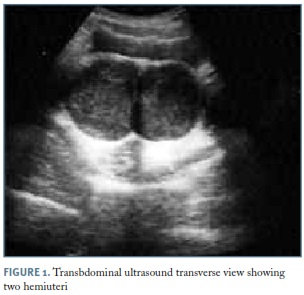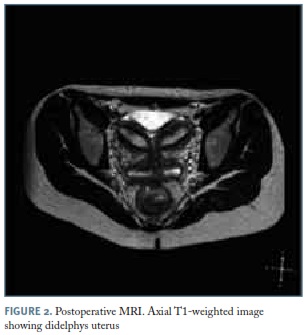Servicios Personalizados
Revista
Articulo
Indicadores
-
 Citado por SciELO
Citado por SciELO -
 Accesos
Accesos
Links relacionados
-
 Similares en
SciELO
Similares en
SciELO
Compartir
Acta Obstétrica e Ginecológica Portuguesa
versión impresa ISSN 1646-5830
Acta Obstet Ginecol Port vol.9 no.5 Coimbra dic. 2015
CASE REPORT/CASO CLÍNICO
A didelphic uterus and imperforate hymen presenting as a double hematometrocolpos - a case report
Duplo hematometrocolopos como forma de apresentação de um caso de hímen imperfurado associado a útero didelfos – a propósito de um caso clínico
Evanira Sousa*, Paula Barroso**, José Coelho,** Vera Loureiro**
Serviço de Ginecologia e Obstetrícia, Hospital de Santarém
*Interna do Internato Complementar de Ginecologia e Obstetrícia **Assistente Hospitalar Graduada, Serviço de Ginecologia e Obstetrícia
Endereço para correspondência | Dirección para correspondencia | Correspondence
ABSTRACT
The rare finding of both a didelphic uterus and imperforate hymen is described in this case. Imperforate hymen is an important cause of abdominal pain in female adolescents, which can usually be diagnosed by thorough clinical history and physical examination. Further investigation may be necessary to exclude other genital tract anomalies.
Keywords: Primary amenorrhea; Abdominal/pelvic pain; Imperforate hymen; Didelphys uterus; Hematometrocolpos.
Introduction
Müllerian malformations represent a wide spectrum of anomaly of the female reproductive tract, usually detected at birth or at puberty. Didelphys uterus is one of the least common anomalies, representing approximately 5 to 7% of müllerian defects1. In this condition, there is non obstructed failure of lateral fusion involving both the uterus and vagina.
Imperforate hymen represents the extreme in the spectrum of embryological variations in hymenal configuration, with reported incidence ranging from 0.014% to 0.1% 2. An imperforate hymen is a congenital resorptive defect which, on the other hand, does not apparently derive from the müllerian ducts. The rare finding of both a didelphys uterus and coexisting imperforate hymen is described in this case of a young patient presenting with pelvic pain and double hematometrocolpos.
Case report
A premenarchal 13-year-old girl was admitted to the emergency deparment with severe suprapubic abdominal pain radiating to her lower back of two days’s durantion. There was no history of nausea, vomiting, altered bowel habits, urinary symptoms or fever. She was apparently asymptomatic until one month before when she was presented to the pediatrics department complaning of lower back pain and was treated as having urinary tract infection. The medical history was unremarkable.
On physical examination we observed normal secondary sexual characteristics. Her abdomen was soft and tender without any palpable mass. Gynecologic examination revealed a bluish bulging hymen. We performed a transabdominal ultrasonography witch showed a didelphic uterus (Figure 1) and a heterogeneous mass in the pelvis measuring about 11 cm. We diagnosed an imperforate hymen with a double hematometrocolpos.
The patient was urgently taken to the operating room and a hymenotomy was performed by a Y-shaped incision. Large quantity of chocolate coloured blood was drained. Intraoperative exam revealed a longitudinal vaginal septum. A few sutures were used to prevente refusion. The postoperative period was uneventful.
One months after surgery she underwent a magnetic resonance imaging (MRI) which confirmed the existence of a didelphys uterus with two cervix and double vagina (Figure 2). No urinary tract anomalies were found.
During 3 month follow up, the girl was asymptomatic and had regular normal menstrual cycles. She was sent to a tertiary referral hospital for uterovaginal anomalies management.
Discussion
The presence of a didelphys uterus and concomitant imperforate hymen is likely to be coincidential, since these portions of the female genitals derive from two distinct embryological structures and these defects occur at different stages of embryological development.
Didelphys uterus arises when midline fusion of the mullerian ducts is arrested, either completely or incompletely. The complete form is characterized by 2 hemiuteri, 2 endocervical canals with cervices fused at the lower uterine segment. Each hemiuteri is associated with one fallopian tube. The vagina may be single or double, with duplication a frequent component. The double vagina manifests as a longitudinal septum that extends either completely (complete septum) or partially (partial septum) from the cervices to the introitus. A complete longitudinal vaginal septum occurs in 75% of these anomalies, although vaginal septa can also coexist with other müllerian duct anomalie3, 4, 5. Patients with a didelphys uterus are usually asymptomatic, unless an obstruction is present.
The hymen is formed from the endoderm of the urogenital sinus epithelium and represents the junction of the sinovaginal bulbs with the urogenital sinus, becoming perforate before or shortly after birth6. An imperforate hymen is the result of failure of canalization of the vaginal plate. The reason for non-perforation of this membrane is unknown.
Imperforate hymen occurs mostly in a sporadic manner, although some familial occurrences have been reported.
It mostly presents during puberty7, 8 although diagnoses in utero9, 10, 11 and during the new born period and childhood9 are also documented.
Imperforate hymen is a rare though a serious cause of abdominal pain in female adolescents, that may not be detected until the onset of menses, when hematocolpos causes symptoms due to expanding pelvic mass. Hematocolpos can be suspected in adolescents girls in the age group of 13-17 years who present with primary amenorrhea, a cyclic pattern of lower abdominal/ /pelvic pain, with or without associated symptoms like back pain (38%–40%), urine retention (37%–60%) or constipation (27%)11-13. The accumulation of menstrual blood in the vagina and uterus may result in a mechanical effect on the urethra, bladder or intestines and lead to the obstructive urinary or intestinal symptoms14. Irritation of the sacral plexus or nerve roots is postulated as a mechanism for the referred low back pain15.
On physical examination, a lower abdominal mass may be palpable, or a pelvic mass may be detected on bimanual rectal examination. Perineal examination reveals a bluish bulging hymen at the introitus. The diagnosis can be established with an abdominal ultrasound showing the pelvic cystic mass.
Other important differential diagnoses of abnormal hymen include vaginal agenesis, transverse vaginal septum and labial adhesion7.
Since imperforate hymen is generally considered not to be associated with other Müllerian abnormalities, further investigation of these patients for concomitant urogenital abnormalities has been thought to be unnecessary11, 16. However, a few associated anomalies with imperforate hymen have been reported in literature and despite their low prevalence, some authors recommend further investigation to rule them out17.
Treatment of hematocolpos or hematometra mainly consists of surgical hymenotomy under general anaethestesia which allows the accumulated blood to drain away. Simple vertical, T-shaped, Y – shaped, cruciform and X-shaped may be used. X-shaped and Y-shaped incisions has the advantage of reduced risk of injury to the urethra which should be stented during the procedure.
Early diagnosis of an imperforate hymen is important, since it can lead to serious complications such as infections, hydronephrosis, kidney failure, endometriosis and subfertility18
The best approach to management of mullerian ducts anomalies should provide relief of symptoms and preserve reproductive ability. Women with a didelphys uterus and bicollis often have good reproductive outcomes without surgical intervention19. Resection of the vaginal septum is easy and commonly performed. The decision to perform metroplasty should be individualized, and only selected patients (women with a long history of recurrent spontaneous abortions or preterm births) may benefit from surgical reconstruction. Referrals to centers with expertise are essential. The surgeon must be experienced with the surgical techniques because the initial procedure is more likely to succeed than follow-up procedures. Reoperation in these cases increases the chance of operative injury and the possibility of a poor functional outcome.
In summary, imperforate hymen is an important cause of abdominal pain in female adolescents, which can usually be diagnosed by thorough history taking and a physical examination. Physicians must be aware of this diagnosis while examining adolescent girls with lower abdominal pain and primary amenorrhea in order avoid delay in the diagnosis and treatment, since late discovery of an imperforate hymen may lead to serious complications. The treatment is surgical and an adequately-performed hymenotomy usually leads to an excellent outcome. As presented in this case further investigation may be necessary to exclude other genital tract anomalies.
REFERENCES
1. Troiano RN. Magnetic resonance imaging of müllerian duct anomalies of the uterus. Top Magn Reson Imaging 2003; 14(4):269–279. [ Links ]
2. Eksioglu AS, Maden HA, Cinar G, and Tasci Yildiz Y. Imperforate hymen causing bilateral hydroureteronephrosis in an infant with bicornuate uterus. Case Reports in Urology, vol. 2012, Article ID102683.
3. Buttram VC Jr. Müllerian anomalies and their management. Fertil Steril. 1983;40(2):159-163. [ Links ]
4. Rock JA, Schlaff WD. The obstetric consequences of uterovaginal anomalies. Fertil Steril. 1985;43(5):681-692. [ Links ]
5. Fedele L, Busacca M, Candiani M, Vignali M. Laparoscopic creation of a neovagina in Mayer-Rokitansky-Küster-Hauser syndrome by modification of Vecchietti’s operation. Am J Obstet Gynecol. 1994;171(1):268-269. [ Links ]
6. Fedele L, Frontino G, Motta F, and Restelli L. A uterovaginal septum and imperforate hymen with a double pyocolpos. Hum Reprod. 2012;27(6):1637-1639. [ Links ]
7. Nagai K, Murakami Y, Nagatani K, Nakahashi N, Hayashi M, Higaki T, Ishii E. Life threatening acute renal failure due to imperforate hymen in an infant. Pediatrics International. 2012;54(2):280-282. [ Links ]
8. Dane C, Dane B, Erginbas M, Cetin A. Imperforate hymen-a rare cause of abdominal pain: two cases and review of the literature. J pediatr Adolesc Gynecol. 2007; 20(4):245-247. [ Links ]
9. Basaran M, Usal D, Aydemir C. Hymen sparing surgery for imperforate hymen; case reports and review of the literature. J pediatr Adolesc Gynecol. 2009; 22(4): e61- 4. [ Links ]
10. Ayaz UY, Dilli A, Api A. Ultrasonographic diagnosis of congenital hydrometrocolpos in prenatal and newborn period: a case report. Medical ultrasonography. 2011; 13(3): 234-236. [ Links ]
11. Liang CC, Chang S-D, Soong Y-K. Long-term follow-up of women who underwent surgical correction for imperforate hymen. Arch Gynecol Obstet. 2003; 269(1): 5-8. [ Links ]
12. Nazir Z, Rizvi RM, Qureshi RN, Khan ZS, Khan Z. Congenital vaginal obstructions: varied presentation and outcome. Pediatr Surg Int 2006; 22:749-753. [ Links ]
13. Wang W, Chen MH, Yang W, Hwang DL. Imperforate hymen presenting with chronic constipation and lumbago: report of one case. Acta Paediatr Taiwan 2004; 45:340-342. [ Links ]
14. Cem D, Banu D, Murat E, and Ahmet C. Imperforate Hymen - A Rare Cause of Abdominal Pain: Two Cases and Review of the Literature. J pediatr Adolesc Gynecol. 2007; 20:245-247. [ Links ]
15. Letts M, Haasbeek J. Hematocolpos as a cause of back pain in premenarchal adolescents. J Pediatr Orthop 1990;10:731. [ Links ]
16. Céline L, Robert A, and Helen M. Imperforate hymen: a cause of abdominal pain in female adolescents. BMJ Case Rep. 2009; 2009: bcr08.2008.0722.
17. Eksioglu AS, Maden HA, Cinar G, Yildiz IT. Imperforate hymen causing bilateral hydroureteronephrosis in an infant with bicornuate uterus. Urology Case Reports 2012;2012:102683. [ Links ]
18. Chang JW, Yang LY, Wang HH, et al. Acute urinary retention as the presentation of imperforate hymen. J Chin Med Assoc 2007; 70: 559–561. [ Links ]
19. Musich JR, Behrman SJ. Obstetric outcome before and after metroplasty in women with uterine anomalies. Obstet Gynecol. 1978; 52(1):63-66. [ Links ]
Endereço para correspondência | Dirección para correspondencia | Correspondence
Evanira Sousa
Hospital de Santarém
Avenida Bernardo Santareno
2005-117 Santarém
E-mail: sousa_evanira@hotmail.com
Recebido em: 30-08-2014
Aceite para publicação: 11-01-2015















